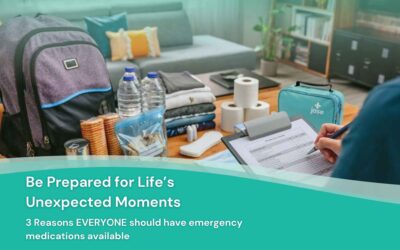Planning is the difference between panic, and preparedness.

How to Make an Emergency Plan for Your Household
When disaster strikes, the difference between panic and composure often comes down to one thing: preparation. While we can’t predict emergencies, we can certainly be ready for them. This guide will walk you through creating a thorough emergency preparedness plan, ensuring you and your loved ones are equipped to face whatever emergencies you may encounter.
Assess Your Unique Needs
The first step in crafting your emergency plan is to assess your specific needs. Consider the natural disasters most likely to occur in your area. Are you in a hurricane zone? Tornado alley? Or perhaps wildfire country? Each scenario requires different preparations.
Key factors to consider:
- Types of potential emergencies in your region (e.g., hurricanes, floods, tornadoes)
- Special needs within your household:
- Seniors
- People with disabilities
- Infants and young children
- Pets
- Medical and dietary requirements

Family Communication and Meeting Points
In the chaos of an emergency, communication is crucial. Start by establishing meeting locations and a robust family communication strategy.
- Choose two family meeting spots:
- Close to home for sudden emergencies (e.g., house fire)
- Outside your neighborhood in case of evacuation
- Develop an emergency contact plan:
-
- Designate an out-of-state contact as your family’s emergency coordinator
- Ensure everyone has this contact’s information saved in their phones and written down
- List emergency contacts as “I.C.E.” (In Case of Emergency) in cellphones
- Use text messages when appropriate as they can often get through when calls can’t.
- Establish a family group chat, or use a family communication app
Plan Your Evacuation Strategy
Knowing how to get out of harm’s way is crucial. Your evacuation plan should be thorough and well-practiced.
- Plan and practice multiple evacuation routes from your home and neighborhood
- Identify modes of transportation and make arrangements if you lack personal transport
- Decide on potential destinations:
-
- Hotels/motels
- Homes of friends or relatives a safe distance away
- Evacuation shelters
- Keep a list of pet-friendly hotels and shelters along your evacuation routes
- Practice evacuating your home twice a year:
-
- Grab your emergency kit
- Drive your planned evacuation route
- Plot alternate routes on your map in case roads are impassable

Prepare for Sheltering in Place
Sometimes, evacuation isn’t the safest option. For scenarios like severe weather or airborne hazards, you might need to shelter in place.
-
Designate safe rooms in your home with:
- Few windows or doors
- Access to TV, radio, and phones for updates
- Ensure you can access necessary supplies and your emergency kit
- If you receive medical treatments or home health care services, work with your provider to determine how to maintain care if you’re unable to leave home for a period of time
Develop a Broader Communication Strategy
Beyond your immediate family, it’s important to know how to communicate with local authorities, emergency services, and your community during a crisis.
- Learn how to receive local emergency alerts and warnings (radio, TV, text, emergency alert systems)
- Keep a list of important phone numbers easily accessible:
- Local police and fire departments
- Nearby hospitals
- Local emergency management office
- Local utilities
- Understand how to contact emergency services if 911 is unavailable
- Know your community’s emergency communication plan and evacuation routes
- Consider joining or following local community emergency response teams on social media
- Learn how to use the American Red Cross Safe and Well website to let extended family and friends know you’re safe
- If you have a landline, keep a non-cordless phone in your home, as it may work even when the power is out

Assign Responsibilities
A well-executed plan requires everyone to play their part. Assign roles and responsibilities to each family member.
- Give each family member age-appropriate tasks for various emergency scenarios
- Discuss how you will work together as a team
- Consider how you will assist family members with special needs or disabilities
Stay Informed and Prepared
Knowledge and preparation are your best defenses in an emergency.
- Familiarize yourself with emergency plans at work, school, or daycare
- If no plans exist in these places, volunteer to help develop them
- Prepare an emergency kit with essentials to help you survive for at least 72 hours
- Document your plan, writing down detailed instructions for each type of emergency scenario
- Use online resources like the American Red Cross form to help document your plan

Practice and Update Your Plan
A plan is only as good as its execution. Regular practice and updates are crucial.
- Run through your emergency plan at least 2-3 times a year
- Update the plan as needed after each practice session
- Review your plan annually
- Replace expired items in your kit
- Adjust your plan as your family’s needs change
Don’t Forget Your Pets
Our furry family members need to be included in all aspects of emergency planning.
- Include pet supplies in your emergency kit
- Ensure your pets are microchipped and wearing collars with up-to-date information
- Plan for their evacuation needs, including carriers or crates if necessary
Remember, if it’s not safe for you, it’s not safe for your pets either.
Creating an emergency preparedness plan may seem daunting, but it’s essential in ensuring your family’s safety. Take it one step at a time, involve all family members in the process, and remember to review and update your plan regularly. With proper preparation, you can face whatever emergencies or disasters that come your way with confidence.
Keep yourself and your family prepared for potential emergencies by having a Jase Case on hand before you need it.
Tune in next week for the next part in our National Preparedness Month series where we will go over in detail how to build an emergency kit with food, water, medical essentials, important documents, and much more!
As always, stay safe, stay healthy, and stay prepared.
– Your partners in preparedness: Jase.com
Lifesaving Medications
Recent Posts
Keeping you informed and safe.
Exploring Dr. William Makis’ Hybrid Orthomolecular Cancer Protocol: Focus on Ivermectin and Mebendazole/Fenbendazole
Exploring Dr. William Makis’ Hybrid Orthomolecular Cancer Protocol: Focus on Ivermectin and Mebendazole/Fenbendazole *Disclaimer: This article is for educational purposes and does not constitute medical advice. Always seek professional guidance.* In the evolving...
Be Prepared for Life’s Unexpected Moments
3 Reasons EVERYONE should have emergency medications avaiable. It's all about access—access to medications and care when you need it most. And when things happen outside of your control that access can disappear.Below are 3 examples of how easily this access can be...
Youth Preparedness: Teaching, Building, and Coping with Disasters
Educating and preparing your children ahead of time means fewer surprises in the event of an emergency.Growing Up Prepared: Empowering Youth in Disaster Preparedness As we observe National Preparedness Month, it's crucial to remember that disasters can strike at any...
Low-Cost and No-Cost Emergency Preparedness Measures
Small steps today, mean a safer tomorrow for you and your loved ones.Low-Cost and No-Cost Emergency Preparedness So far in our series for National Preparedness Month this September, we've already covered How to Make an Emergency Plan for Your Household and How to...





